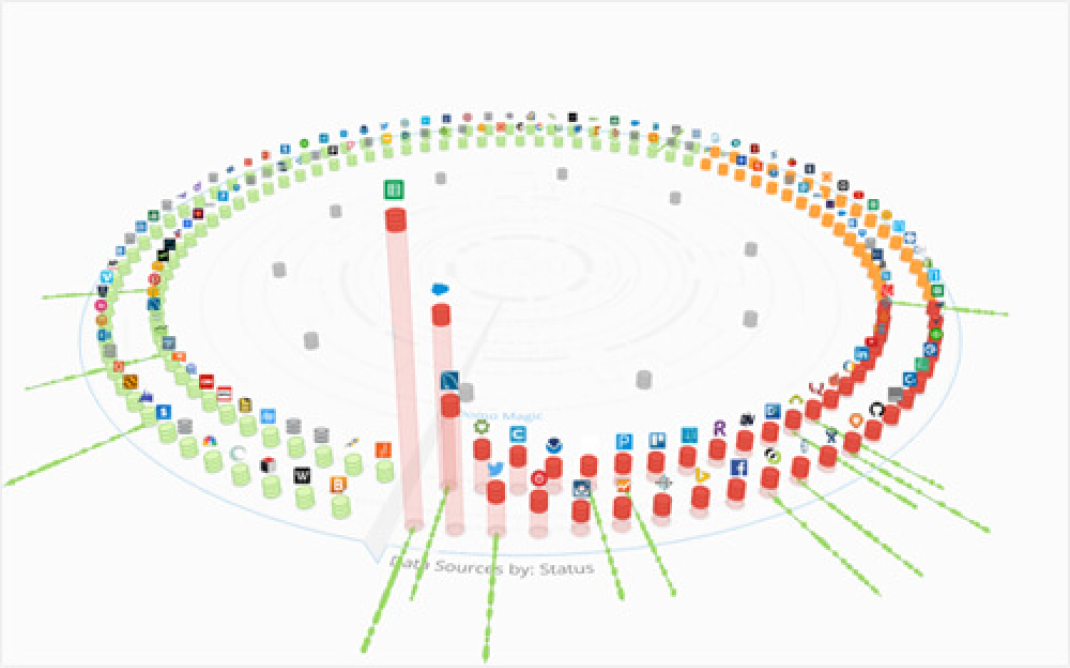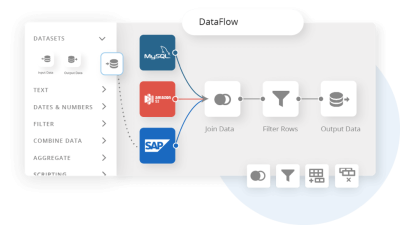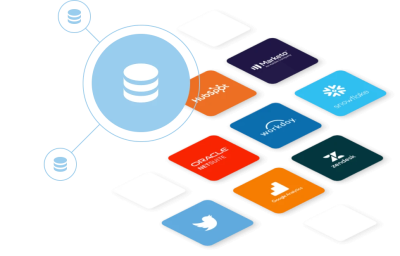Guide to Business Intelligence and Data Warehouses
What is business intelligence and data warehousing?
Business intelligence and data warehousing both organize and interpret data in ways that surface critical information needed for making business decisions. Data warehousing is typically part of a larger business intelligence architecture that collects, stores, and organizes data, which it then supplies for more in-depth analysis and interpretation.
A robust business intelligence (BI) architecture almost always includes a data warehouse. While the terms are often heard together, they are still distinct ways of handling data. Here’s what you need to understand about the differences between business intelligence and data warehouses, how they work together, and how your organization benefits from their synergy.

What is business intelligence?
Business intelligence is the process by which organizations use data to make smarter decisions. Driven by data and technology, BI is just as much a set of tools as it is what people do with those tools: interpret data, form strategies, analyze customer behavior, optimize operations, explore market opportunities, and improve productivity.
To help illustrate, imagine walking into a meeting where a presenter is showing slides. Each slide is covered in numbers. You have no context for the material. The dizzying amount of numbers has no meaning to you. After the meeting, you still don’t know what the numbers mean, how they are supposed to help you, or what to do now.
That’s where business intelligence steps in. If BI were the presenter in that meeting, BI would take all the numbers on those slides and interpret them. The slides would have visuals, summaries, and projections, rather than a bunch of context-less numbers. Now, you understand that all those numbers represented specific supply chain metrics. Charts showed exactly where the organization was making significant profits and where it was losing money. You would walk away from the meeting understanding trends and learning more about how individual parts of the business are performing. You’d know which distribution routes need to be improved and how to better diversify your suppliers. Based on the BI analyses, you would have specific recommendations for how to reach a new target audience at a lower cost.
Using procedures, software platforms, and analysis, business intelligence takes data and translates it into this kind of narrative presentation. BI can include a wide range of tools, including visuals (like charts and graphs), data mining tools, best practices, and company infrastructure—anything to help make the data understandable and actionable.
What is data warehousing?
Data warehousing is the practice of gathering data from many sources into a central repository so people can make better business decisions.
Data warehouses collect data and store it securely. When created correctly, data warehouses make it easy to organize, manage, and retrieve data. If you are looking for a data warehouse, some of the most prized qualities are scalability, data governance, data security, and the ability to integrate with existing infrastructure.
For example, in healthcare, data warehousing is vital for storing information. Hospitals can use data warehouses to compile patient records, types and frequencies of medical procedures done, insurance claims, and lab test results. Having all that information in one place is critical for the hospital to understand the health needs of the local population, make financial decisions, keep facilities staffed appropriately, and know what kinds of products may be at risk of supply chain shortages.
Data warehousing is so useful that it’s likely to become a $11.2 billion market by 2028. With the advent of cloud computing, data warehousing in the cloud can hold far more data than many traditional and on-premises data storage options. The more data a warehouse can hold, the more history, trends, insights, and use cases a company can extract from its raw numbers.
Business intelligence vs. data warehouses
A solid business intelligence architecture needs a data warehouse. BI and data warehouses are not the same thing, but they do work together. A data warehouse provides an essential source of data that’s a core part of an overarching BI architecture to understand what’s happening in your business. In many ways, BI is the bridge between the vast amounts of data in a warehouse and the end user.
Is it possible to have business intelligence without a data warehouse? Not successfully. BI is only as good as the data it has access to. BI can’t create accurate statistical models without enough relevant data. BI is a means of translating the loads from the data warehouse into trends, insights, and actionable tasks. Using SQL-driven queries, BI can interpret the data provided by the warehouse to make tough business calls.
You can think of data warehouses as a service that provides the information to business intelligence. Data warehouses are similar to physical warehouses: they gather goods, inventory them, label them, organize them, and, when needed, deliver them out to requestors. When data is coming from various sources, the data warehouse is a central repository so all the data is available in a single place. Data warehouses can also aggregate, categorize, and summarize data so it’s easy to retrieve for business intelligence purposes.
Then, using the information supplied by the data warehouse, business intelligence software can analyze the numbers. Dashboards and other visuals help people understand what’s happening and what the data means. For example, you can’t have key performance indicators (KPIs) without a source of aggregated data (the data warehouse) and some way to determine if the KPI has been met successfully (business intelligence).

Database vs. data warehouse
Don’t get confused—while databases and data warehouses sound similar and both store data, they do so in different ways and have several important differences. Data warehouses are usually a layer built on top of traditional databases. Here are some of the biggest distinctions between databases and data warehouses:
- What their purpose is. If an organization needs a collection of simple and detailed data to retrieve anytime, a database will serve that purpose perfectly. However, the purpose of a data warehouse is to store data from many sources for the purpose of analysis and queries.
- What they do with the data. All a database does is record data and transactions, usually in a table format. Data warehouses store data as well, but they can also analyze and summarize the data to a small degree—enough to be able to present data visually and answer queries.
- What they store. Yes, they both store data. However, databases usually store detailed data and every single data point from a single application. The data in a database is usually only current. On the other hand, data warehouses store summarized data from multiple sources in various formats. Data warehouses can also store vast amounts of historical data.
- Where they get their data. In most cases, databases only get data from a single application. For example, a healthcare organization may use a database for patient records. An e-commerce company may use a database for customer purchasing information. In both cases, the database only gets the data from one source. Data warehouses gather information from many different applications, like Excel sheets, Salesforce or other CRMS, ERP software, and apps.
- How they process information. There are two primary processing systems. Online transaction processing (OLTP) is geared toward transactional processing and real-time updates, making it a great fit for databases. The other processing system is online analytical processing (OLAP). Data warehouses usually use OLAP because it can handle more complex data analysis and reporting.
- How quickly they work. Databases work in real-time. If you need information, you can get it immediately, largely because the function is so simple. Data warehouses may have a slight lag, depending on how quickly the warehouse can import data and organize it. However, data warehouses usually still end up being the faster option in the long run because traditional databases usually can’t process the needed data that a warehouse can without suffering strain, increased load time, and reduced performance.

Connect and power your data warehouse to your business intelligence platform
Business intelligence and data warehousing build on each other to make even more insights available. Using the two in tandem comes with numerous benefits. Here are some areas where business intelligence and data warehousing are exponentially useful when used together:
Data mining
Data mining is the process of searching through a large batch of data and identifying patterns. An organized and robust data warehouse supplies raw data, which companies can mine through to find patterns and trends. The labels, trends, and patterns revealed by the data mining are then used in business intelligence to inform strategic decisions.
Metrics
With the power of both business intelligence and data warehousing, you can get more metrics, with more accuracy, and understand what to do with the results. Metrics such as sales figures, campaign performance, lead generation, and customer retention rates are all numbers you’ll need to be stored and visualized accurately in order to make hypotheses and forecasts for your next major business decision.
Querying
If you want the right data, you have to ask the right questions. Use queries to understand the revenue of a campaign, how much it cost, and what factors may have contributed to its success or failure. Querying shines a light on insights for more incisive business intelligence.
Statistical analysis
In the realm of business intelligence, statistical analysis usually takes the form of using a sample of data to understand trends about a larger population. Statistical analysis is essential in projecting sales, identifying patterns in historical data, and assessing supply chain risks.
Data visualization
Humans can understand a visual much faster than they can understand raw data. The Harvard Data Science Review points out that data visualizations also help people identify trends and anomalies that other statistical models may miss, such as unusual distributions of data, clusterings, gaps, missing values, and outliers.
Data is the foundation of business intelligence
Data warehouses provide the raw information that business intelligence needs. With a large supply of accurate data to populate dashboards, BI teams can identify trends and predict new ones, perform statistical analysis, and evaluate ROI. Making data-driven business intelligence decisions is only beneficial for the business with the foundation of a reliable central repository of information.
Business intelligence and data warehousing FAQs
Have additional questions about business intelligence and data warehouses or how to choose the best platforms? We’re here with answers.
Is data warehousing part of BI?
Usually, data warehousing is a significant part of an overarching BI architecture. Companies can have data warehouses that gather and store data. Then, the data warehouses can pass the data to business intelligence software that analyzes the data and makes sense of it. It’s possible to have business intelligence without a data warehouse, but the organization wouldn’t have the holistic understanding of trends that come with a comprehensive data warehouse.
What is the distinction between business intelligence and data warehouse?
A data warehouse, which stores information, is distinct from business intelligence, which has more to do with analyzing and interacting with the data to make better business decisions.
What is the role of data warehousing in your business intelligence architecture?
Data warehousing has a vital role in supporting business intelligence architecture. Data warehousing helps store and process data to make it more accessible for the business intelligence architecture.
What are the components of BI data warehouses?
BI data warehouses have several components to help clean and organize data, such as a central database, metadata, access tools, ETL (extract, transform, load) tools, and query functions.
What is BDA vs. BI?
Big data analytics (BDA) is typically used for understanding trends in extremely large, broad, and complex data sets, whereas business intelligence uses more specific data and sophisticated tools to understand data through the lens of making business decisions.
Check out some related resources:

11 ETL tools to consider in 2025

10 Best Data Integration Platforms in 2025






